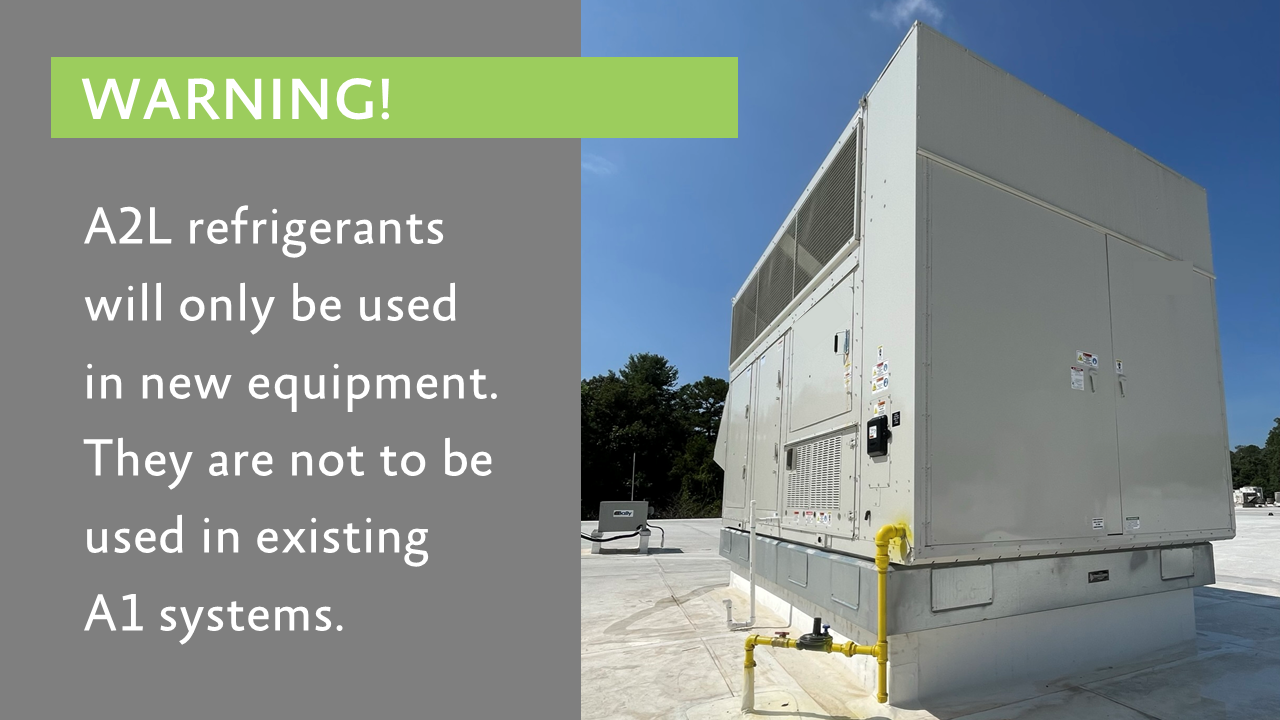January 20, 2025
Transitioning to A2L Refrigerants: Enhancing Safety and Sustainability in HVAC Systems
A2L refrigerants are being introduced as a vital step toward minimizing the environmental footprint of heating, ventilation, and air conditioning (HVAC) systems.
Starting in 2025, these pivotal changes will significantly influence various aspects of the construction and renovation landscape, affecting everything from existing building upgrades to the replacement of outdated equipment and the design of new structures. Consequently, industry professionals and stakeholders must proactively embrace these new guidelines, exploring A2L refrigerant options to ensure they meet the evolving regulatory standards while promoting a more sustainable future.
Let’s review the key points regarding A2L refrigerants:
- Lower Global Warming Potential (GWP):
- Current refrigerants, like R-410A, have a high GWP and significantly contribute to climate change.
- A2L refrigerants have a much lower GWP, which aligns with international climate goals, including the Kigali Amendment to the Montreal Protocol.
- Regulatory Compliance:
- Governments and organizations are phasing out high-GWP refrigerants through regulations like the U.S. AIM Act (American Innovation and Manufacturing Act).
- A2L refrigerants comply with new standards while maintaining HVAC efficiency.
- Mild Flammability:
- A2L refrigerants are classified as “mildly flammable,” but they are safe when used with updated safety measures.
- This classification offers a balance between environmental benefits and manageable safety considerations.
A2L refrigerants represent a critical step toward sustainable cooling solutions, addressing climate change, and meeting regulatory requirements. The transition to A2L refrigerants also introduces new safety requirements to address their mild flammability, primarily focusing on fire and hazard communication.
Here is a summary of some new requirements in buildings.
- Fire-Resistant Shaft Enclosures:
- Refrigerant piping that passes through two or more floors must be enclosed in a fire-resistant shaft.
- The shaft must comply with International Building Code Section 713.
- Ventilation (natural or mechanical) for the refrigerant shaft must adhere to IMC Section 1190.3.2.
Note: Unlike current regulations, which require no special shaft or protection for installations, this new requirement will necessitate using existing shafts or constructing new ones.
- Protection in Concealed Spaces:
- Refrigerant piping located in concealed areas, less than 1.5 inches from the nearest edge of framing elements (e.g., studs, joists, rafters), must be shielded.
- Shield plates must:
- Be made of 16-gauge steel (0.0575 inches thick).
- Extend at least two inches beyond both sides of the pipe.
- Labeling for Safety:
- Refrigerant piping must have labels indicating the refrigerant designation and safety group classification.
- For A2L and B2L refrigerants, labels must include the warning:
“WARNING – RISK OF FIRE, FLAMMABLE REFRIGERANT. “ - The lettering must be at least 1/2 inch tall.
- Labels must be placed at intervals of no greater than 20 feet along the piping or insulation.
These measures aim to ensure compliance with safety standards while addressing the unique risks associated with these newer refrigerants.
More information can be found on the U.S. Environmental Protection Agency (EPA) website at https://www.epa.gov/climate-hfcs-reduction/regulatory-actions-technology-transitions.
If you want to learn more about the impacts of the new A2L refrigerant regulations on your HVAC systems, please email Scott Walthour, Arium AE Principal and Lead MEP Engineer, or call 410-730-2300. Our team is available and ready to help you.
